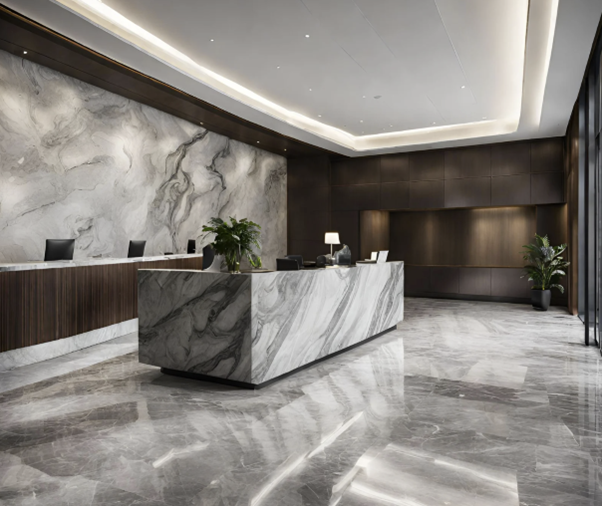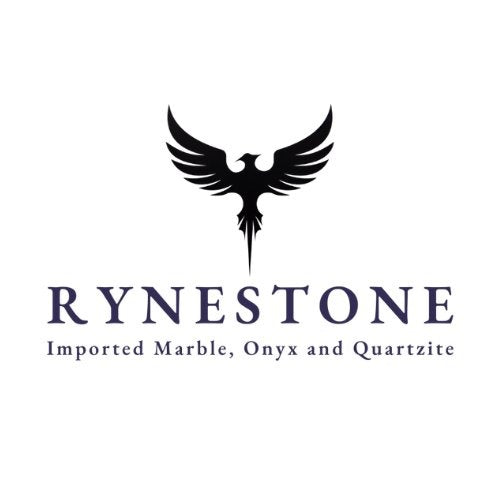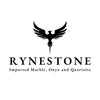
How to Pick Marble for Your Home/Office?
Share
Is Marble Right For You?
When crafting a home or office, you want it to exude grandeur, feel luxurious, and stand the test of time. If this resonates with you, then Marble is the ideal choice. This natural material not only elevates any space but can also be repolished so it looks just as good after 20 years as it did the day it was installed.
If you have decided that Marble is for you, then this guide will help give you the information you need to select the Marble to build the space of your dreams.
Where can Marble be used?

Marble can look beautiful as flooring, on walls, as countertops and to make furniture such as tables and chairs.
The decision on which Marble and how much of it to use where is dependent on several factors.
- Your Budget.
- Your Usage.
- Your Interior Design Concept
Here are some tips from Mumbai’s top Marble Company on how to pick the right Marble for your home or office.
Your Budget
Marble can start from INR 100-150 per Sqft for Indian varieties. Imported varieties generally start at INR 270-300 for Beige and some Grey Marble(as shown below). And it can go upto INR 7-8,000 per Sqft for some varieties of White Marble.
Marble makes up roughly 15-20% of the total cost of Interiors, but it elevates the space like nothing else. You must decide how much and which Marble is right for your space.
Your Usage
This is where we must begin to differentiate between Onyx, Marble, Granite and Quartzite. They are all natural materials. However, all have different properties.
Onyx
Onyx is the softest. Therefore, it is not recommended you put it on floors or surfaces that will endure heavy usage such as kitchen countertops. Onyx also has the special property of being translucent so light can pass through. It is a beautiful way to illuminate a room. Onyx works best as wall cladding and on tabletops that will not see heavy use. (Top tip: if you decide to put a backlight behind Onyx, make sure that the lights are easy to change. You should not have to pull out the onyx slabs to repair the lights in case of spoilage)
Note- there are also materials classified as semi-onyx (Shown below), which are not completely translucent, but portions of the material let light pass through. This means that some veins and patterns can be seen when they are backlit.

Marble
Marble is harder than onyx. It can retain a polish well and it useable across most surfaces. Whether it be floors, walls, countertops, etc. The only usage not recommended for Marble is on kitchen countertops. This is because Marble is softer than granite and quartzite, and things like the constant pounding of a mortar and pestle may damage Marble over time. Even within Marble, some Marble is harder than others and may be more suitable for high traffic areas. There are no general rules about this. It varies from Marble to Marble and block to block. The objective is to find a good Marble supplier who understands his material and can guide you on the same.
Granite
Granite is harder than Marble. It generally differs from Marble because of it’s even spotted texture. It is great for the high usage countertops like kitchen tops because it can take a beating and show very little wear and tear. Granite generally does not look as grand as Marble, therefore it is not advised to put it on every surface.

Quartzite
Quartzite is as expensive as it is interesting. Quartzite is an extremely hard material composed of quartz crystals. It is by far the hardest material on this list. Therefore, it can be put on extremely high usage areas such as countertops. Unlike Granite, it looks gorgeous with varying patterns and strong colours. Due to it’s hardness, it can hold an good polish. Properly polished Quartzite will always be one of the first things to draw the eye when one steps into a room. Quartzite is highly recommended for tabletops and walls, but it can be used everywhere including floors, countertops, to make furniture, etc.
Colour:
Here are some thumb rules for how different colours of Marble affect a space.
- White Marble can make a room feel larger than it is. It does this because it reflects tons of light. It works especially well in places such as small bathrooms that can seem much larger than they are.
- Grey/Black Marble is very soothing and makes a space look rich and relaxing.
- Beige Marble doesn’t draw attention to itself. It shifts emphasis to the other décor in your space. It is the perfect canvas when you don’t want Marble to be front and centre in your space.
- All other Marble can be broadly grouped into Exotic Marble
Note- Keep in mind that some Marble absorbs stains and colours. Marble can be treated beforehand to minimize absorption. Enquire with your vendor about Anti-Porous Treatment for your marble and if it is necessary. Some types of white Marble can be more absorbent than other types. It should not be used in places where staining is likely such as kitchens where turmeric stains are common. Stains are generally more visible on White Marble due to its colour.
Marble and other natural materials generally goes well with other natural and manufactured materials such as wooden furniture, stone, composite panels, fabric carpets and curtains. The specifics of each should be best decided by your architect or interior decorator.
Consistency of Texture:
Consistency of Marble can be broadly categorized into 2 types:
Heterogenous- Marble of this type has an uneven pattern and is inconsistent. This could be in the form of veins, waves, etc.
Homogenous- Marble of this type has an even pattern. It is consistent. This could also be in the form of veins, waves, no patterns etc.

Heterogenous texture will be very eye catching and can draw attention to itself. Homogenous patterns, due to their uniformity, don’t draw the eye as much. This is an important thing to consider when you want to decide whether you want to keep the attention on your Marble or your other interiors.
Density of texture
Is the Marble Busy?
As a rule of thumb, less dense marble patterns are used for bigger uses such as flooring because they don’t draw the eye. More Dense patterns are used for smaller applications such as tabletops to accent the other furnishings.


Orient Grey and Alexander Grey both are grey marbles with red veins. However, Alexander Grey looks much more busy than orient grey because its veins are thicker and denser, therefore, Alexander Grey cannot be used as widely as Orient Grey. It is best used on a highlighter wall or a tabletop, whereas Orient Grey goes well as flooring due to it’s subtle texture.
Some other factors to consider:
The Origin of the Marble:
The origin of Marble affects the quality, price, and availability of the Marble. Some types of Marble, such as Satvario (from Italy) and Michaelangelo (from Portugal) comes from only certain locations.
Italian Marble vs Indian Marble
Italian and Portuguese Marble is considered to be the finest in the world because it has a high degree of purity, whiteness, and veining. However, it is also scarce and difficult to obtain.
On the other hand, Indian Marble is local and affordable but does not have the range of colour that imported marble does.
General Pricing Information (This is only indicative. Marble prices vary from block to block)
- White Marble for a Bright and Spacious Look: Some examples are Carrara, Calacatta, Satvario, Michaelangelo and Lassa White Marble. White Marble flooring price ranges from ₹500 to ₹8000 per square foot.
- Black/Grey Marble to Add a Luxurious Look to Your Space: Some examples are Nero Marquina, Black Forest, Black Marquina Marble, Ash Grey Marble, Grey Bardilio Marble, and Grey Roma Marble. It can also add a touch of luxury and elegance. However, black Marble can show dust more easily, so it needs regular polishing and cleaning. Black/ Grey Marble flooring price ranges from ₹300 to ₹550 per square foot.
- Choose Beige Marble for a Classic and understated Look: Some examples are Bottechino, Bianco Crema, Danish Cream, Brecia Onichita and Royal Beige. It goes well with most other color or material. Beige Marble flooring price ranges from ₹250 to ₹450 per square foot.
Which Marble Finish is Right for Your Needs?
Marble can have different surface finishes that affect its appearance and performance. Some of the common finishes are:
- Polished: Glossy, honed, . Achieved with diamond abrasives. It enhances the colour and veining of the Marble and makes it easy to clean. However, after 5-7 years, it requires repolishing depending on usage and type of marble. Polished Marble is suitable for most surfaces. Polishing cost ranges from ₹55 to ₹85 per square foot.
- Leather Finish: This is a matte finish achieved with chemicals and special abrasives. What you lose in lustre, you gain in texture. It gives Marble a rugged texture that you can’t help but run your fingers across. It also affects the different mineral deposits in Marble differently, so the veins and other patterns can be felt as distinctly on the Marble. A beautiful way to add texture to a space. Excellent choice for wall cladding. Prices for this finish range from INR 60-100 per Sq ft depending on the marble.

- Lasered Finish: This is done with chemicals and jet sprays to carve grooves and pockets into the marble. Gives Marble a striking and rustic look. Great for wall cladding. Prices range from INR 150-400 per Sq ft.

- Etched Finish: This includes any deliberate patterns made in Marble such as fluted patterns, etc. Price is dependent on the patterns required.
Installation and maintenance
Marble is a heavy and brittle material that requires professional installation and care. Some of the factors to consider are:
- Installation Cost: This depends on the size, shape, and pattern of the Marble tiles. It also includes the cost of materials, labor, and transportation. Installation cost ranges from ₹125 to ₹225 per square foot.
- Labor Cost: This depends on the skill and experience of the installer. It also includes the cost of cutting, laying, grouting, and sealing the Marble. Labor cost ranges from ₹50 to ₹100 per square foot.
- Inlaid Flooring Cost: This is an optional and decorative feature that involves embedding different types of Marble or other materials into the Marble floor. It creates a unique and artistic look and adds value to the Marble floor. However, it also increases the cost and complexity of the installation. Inlaid flooring cost ranges from ₹400 to ₹1200 per square foot.
- Maintenance Cost: This depends on the type, finish, and usage of the Marble. It includes the cost of cleaning, sealing, polishing, and repairing the Marble. Maintenance cost ranges from ₹50 to ₹75 per square foot in every repolishing cycle (in about 5-7 years).
Marble is a versatile and beautiful choice for any home or office. For a 28-year industry veteran, trust Rynestone, one of Mumbai's oldest Marble Shops, to guide your selection. Your dream space awaits!






